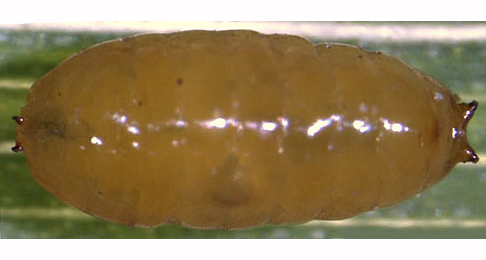|
||||||
|
LENS. Lentil. [Fabaceae] |
|
Two species of Lens are recorded in Britain. Both are introduced. Three British miners are recorded on Lens in Britain. A key to the European miners recorded on Lens is provided in Bladmineerders van Europa. |
|
Key for the identification of the known mines of British |
1a > Leaf-miner: A short, irregular, linear upper surface mine on any part of the leaf. Also recorded from young pods (Bland, 1997a). Long corridor mine. As a rule the first part of the mine is lower-surface, the later part upper-surface. Often the loops are so dense that a secondary blotch is the result. Because upper- and lower-surface corridor segments often cross, the mine obtains a strange array of transparant patches. There is no association with the midrib. Frass in strings and thread fragments. Pupation outside the mine; exit slit in upper epidermis. Mine not associated with the veins or midrib of the leaf (It is this character which enables distinction from another Agromyzid pest species - Liriomyza huidobriensis). The larvae may leave one leaf (if not large enough) and enter another leaf, via the petiole). It exits the leaf to pupate through a semi-circular slit in the upper surface of the leaf. |
|
Liriomyza bryoniae (Kaltenbach, 1858) [Diptera: Agromyzidae]. |
1b > Leaf-miner: Corridor leaf-mine in leaves. An upper surface linear mine with frass in conspicuous greenish strips, largely alternating at each side of the channel (Spencer, 1976: 241). Upper-surface, unbranched corridor, relatively broad from the start on, but only weakly widening subsequently. The fresh mine is bright green, but turns whitish, later brown, quickly. Frass in a wide green band in the centre of the corridor, with small black granules at either side. Pupation outside the mine. Forms an upper surface mine, with the frass in a green strips. |
 Liriomyza congesta puparium Image: © Willem Ellis (Bladmineerders van Europa) |
|
Liriomyza congesta (Becker, 1903) [Diptera: Agromyzidae]. |
1c > Leaf-miner: In the first instar the larva mines the leaves, forming short, irregular, blotch-like mines, but in later instars it lives externally, feeding in spun leaves and often twisting those of tender shoots. Larval head light-brown or yellowish brown, edged with black postero-laterally, ocellar area blackish; prothoracic plate black edged with whitish anteriorly; abdomen dull dark green; pinacula distinct, black, sometimes brownish but with black bases to setae; anal plate large, black (Bradley et al., 1973). Small, full depth mine without a definite shape; little frass. Some silk is deposited in the mine. The larva soon leaves the mine and continues feeding among spun leaves. |
|
Cnephasia incertana (Treitschke, 1835) [Lepidoptera: Tortricidae]. |
| Last updated 05-Jul-2019 Brian Pitkin | ||
